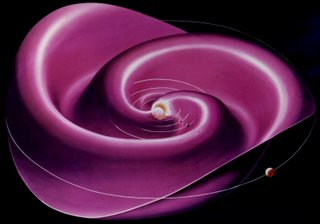Plasma & Spin - 2

_______________________________________________________
A schematic representation of the Heliospheric current sheet, the largest structure in the Solar System, resulting from the influence of the Sun's rotating magnetic field on the plasma in the interplanetary medium (Solar Wind). It is sometimes informally refered to as the 'Ballerina Skirt' model.

Ordinarily, the current sheet circles the Sun's equator like a wavy skirt around a ballerina's waist. But during the double north pole event of March 2000, the current sheet was radically altered: The waviness increased. Irregularities appeared. Its topology "morphed" from a ballerina's skirt to a giant seashell.
Cellular structure
Narrow sheets with sharp gradients may separate regions with different properties such as magnetization, density, and temperature, resulting in cell-like regions. Examples include the magnetosphere, heliosphere, and heliospheric current sheet.
From the cosmological point of view, the most important new space research discovery is probably the cellular structure of space. As has been seen, in every region of space which is accessible to in situ measurements, there are a number of `cell walls', sheets of electric currents, which divide space into compartments with different magnetization, temperature, density, etc

Saturn's rings
in which certain effects have been suggested are due to dusty plasmas (false colour image)
Ultracold Plasma
It is possible to create ultracold plasmas, by using lasers to trap and cool neutral atoms to temperatures of 1 mK lower. Another laser then ionizes the atoms by giving each of the outermost electrons just enough energy to escape the electrical attraction of its parent ion.
The key point about ultracold plasmas is that by manipulating the atoms with lasers, the kinetic energy of the liberated electrons can be controlled. Using standard pulsed lasers, the electron energy can be made to correspond to a temperature of as low as 0.1 K, a limit set by the frequency bandwidth of the laser pulse.
The ions, however, retain the millikelvin temperatures of the neutral atoms. This type of non-equilibrium ultracold plasma evolves rapidly, and many fundamental questions about its behaviour remain unanswered. Experiments conducted so far have revealed surprising dynamics and recombination behaviour that are pushing the limits of our knowledge of plasma physics.

_______________________________________________________
A Quark Gluon Plasma QGP is formed at the collision point of two relativistically accelerated gold ions in the center of the STAR detector at the RHIC.
A quark-gluon plasma (QGP) is a phase of quantum chromodynamics (QCD) which exists at extremely high temperature and density. It is believed to have existed during the first 20 or 30 microseconds after the universe came into existence in the Big Bang.
Experiments at CERN's Super Proton Synchrotron (SPS) first tried to create the QGP in the 1980s and 1990s, and may have been partially successful. Currently, experiments at Brookhaven National Laboratory's Relativistic Heavy Ion Collider (RHIC) are continuing this effort. Three new experiments running on CERN's Large Hadron Collider (LHC), ALICE, ATLAS and CMS, will continue studying properties of QGP.

_______________________________________________________
Hall effect thruster - Plasma Thrusters.
The electric field in a plasma double layer is so effective at accelerating ions, that electric fields are used in ion drives
Double layers involve localised charge separation, which causes a large potential difference across the layer, but does not generate an electric field outside the layer. Double layers separate adjacent plasma regions with different physical characteristics, and are often found in current carrying plasmas. They accelerate both ions and electrons.
More on PLASMA SCIENCES
Credits @ wikipedia - Plasma (physics)
_______________________________________________________
_______________________________________________________
Famous Quotes: The most important plasma & space
research discovery is the cellular structure of space
_______________________________________________________
_______________________________________________________
Labels: Plasma


<< Home